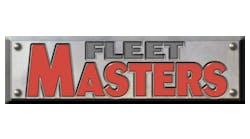York County, Va, winner of the 2014 Fleet Masters award for small fleets, achieved twin goals in 2013: implementing a new fleet information management system and a new automatic vehicle location program (AVL), using telematics.
“We’ve managed our fleet assets and components through the utilization of some type of electronic fleet-management system since 1989,” says Denny Kincade, fleet and maintenance superintendent for York County. “Both technology and the county fleet have grown over the years, and we’ve done our best to keep up with the many new and innovative features and improvements that are introduced to asset-management software year after year.”
York County is one of three winners of the 2014 Fleet Masters Award (the U.S. Air Force and Sarasota County are the others). The award is presented each year byConstruction Equipment and the Association of Equipment Management Professionals (AEMP), and is judged on categories such as finance (financial management, acquisition, warranty and performance guarantees); information management (benchmarking, life-cycle costing, specifications and technology); policies (safety, employee training, environmental and human resources); and controls (outsourcing, parts management, preventive maintenance, and shop and facilities management).
Apply now for next year's Fleet Masters Award.
But keeping up with technology can be a challenge, particularly for a diverse fleet of 1,000 vehicles and pieces of equipment.
To do the job, York County purchased and implemented AssetWorks, a fully integrated information-management/software system. “The decision was based on a number of factors, including cost, accessibility with the county network and infrastructure, use by neighboring municipalities, and the company’s reputation,” Kincade says. “We had also entered into a contract with the vendor in 2012 to deploy its flagship fleet-management software solution, called FleetFocus.”
The county uses FleetFocus to capture labor in real time, schedule shop activities and employees, access fleet data for long-term planning, and run detailed reports.
“Also, the Fleet Division can share certain pieces of data with our customers through a front-end portal that can be accessed by nonfleet personnel,” Kincade says.
Kincade explains that since the program is Web-based, it didn’t require installation on every computer in the Vehicle Maintenance Division. “The program is located on a secure server that every employee within the division can access through their Web browser,” Kincade says. “This feature saved a great amount of time, money and resources, since it didn’t require someone to work on each and every PC that uses the software.”
The move also had environmental benefits for the county. “It has helped make us a paperless, green facility,” Kincade adds. “All work is done through the database, and that includes work order write-up, parts management, and fuel and motor pool management.”
One specific feature Kincade likes is the electronic PM checklist. “Our techs can electronically complete and sign-off on their inspection checklists without ever having to print it on a piece of paper,” he says. “Now through implementation and setup of the new software, these checklists can be electronically loaded and attached to every work order automatically, and the technician can complete it right from his personal computer. There’s no more fumbling with or storing costly paper documents and recordkeeping.”
Perhaps the most impressive aspect of the changeover was how quickly the implementation happened. “The timeline from purchase to completion was an aggressive one, only allowing for three months to set up and individually enter each piece of county equipment to be tracked in the database,” Kincade says.
The data entry effort required a tremendous amount of time to ensure all the data were entered correctly, including meter/hour readings, PM schedules, and parts history to name a few.
Dovetailing with the AssetWorks software, the county equipped 100 of its vehicles with Networkfleet telematics devices that provide it with Web access to real-time information such as GPS maps, dashboards, reports, and automatic alerts via email and text messaging. The two systems are designed to share information between them so that the county can use the telematics data for planning and reporting.
“For example, we’ve set up a system of diagnostic trouble codes reported through Networkfleet that automatically generate service requests and work orders in the AssetWorks software,” Kincade says. “That way, our maintenance staff can receive the trouble code, open up a work order automatically, and address the issue before a larger problem occurs.”
In addition to streamlining maintenance for its vehicles, York County has achieved its goals of better utilizing resources, monitoring employee productivity, increasing safety awareness, and reducing fuel use, miles driven, and idling.
Telematics has helped the county reduce idling, as alerts are sent if a vehicle is idling for more than five minutes. Speeding has also been reduced with alerts triggered if a vehicle exceeds the speed limit by 8 mph for more than one minute. Employee behavior has been modified as well—as alerts are triggered for vehicles entering restaurants, shopping centers, and other prohibited areas. This has reduced violations of the division’s vehicle usage policy.
“After one year of implementation, we’re seeing a nice reduction in overall fuel costs, as well as improved vehicle usage and overall fleet efficiency,” Kincade says.
In addition to saving wear and tear on vehicles, and extending their life expectancy, the county has been able to demonstrate a significant return on investment: an estimated mileage reduction of 57,508 miles annually; an estimated annual fuel cost savings of $14,260; and an approximate net savings of $51,395 a year.





